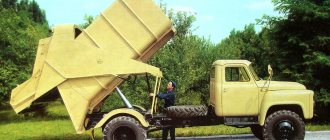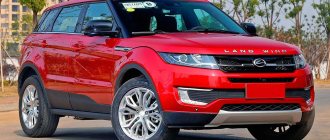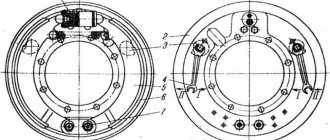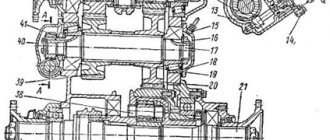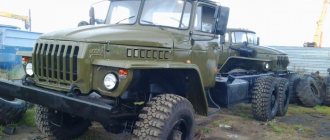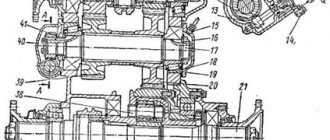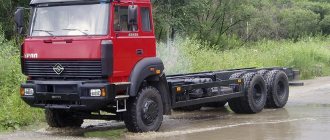| Automotive | |
| Type | public corporation |
| Base | 1941 |
| Former names | Ural Automobile Plant named after Stalin |
| Location | Russia Russia: Miass (Chelyabinsk region) |
| Key figures | Kadylkin Viktor Sergeevich (Managing Director) |
| Industry | Automotive industry |
| Products | Cars |
| Turnover | ▲ RUB 19.21 billion (2015)[1] |
| Net profit | ▲ RUB 1.02 billion (2015) |
| Number of employees | ▲ 13,497 (2007)[2] |
| Parent company | OJSC "GAZ" |
| Auditor | FinExpertiza LLC (2007)[2] |
| Website | [www.uralaz.ru www.uralaz.ru] |
K:Companies founded in 1941
The Ural Automobile Plant
(UralAZ, until 1962 -
the Ural Automobile Plant named after Stalin
) is a Russian manufacturer of trucks. Full name: Joint Stock Company “Automobile Plant “Ural””. Located in the city of Miass, Chelyabinsk region.
Founded by decision of the USSR State Defense Committee. Until 1991, it was a state enterprise within the USSR Ministry of Automotive Industry. It was privatized and in 2011 was controlled by the GAZ Group (Basic Element holding of Oleg Deripaska). Managing Director - Viktor Kadylkin.
History of the Ural automobile brand and the meaning of the logo
A car with the Ural logo is now known not only in Russia, but also abroad.
It has noticeably changed since its first appearance on the market and is currently not inferior in quality, and in some ways even surpasses the characteristics of modern trucks from other brands. The century-old Ural car, the logo of which consists of the brand name, might never have appeared on the market if not for the terrible war, because of which the automobile plant was moved to Miass.
Renaming the enterprise
In 2011, UralAz (Ural Automobile Plant), which by this time had already produced more than 1,400 thousand vehicles, was renamed “Ural”. The enterprise became the main one in the Trucks holding. To date, in addition to him, the group includes OJSC URALAZ-Energo, OJSC Saransk Dump Truck Plant, OJSC Social Complex.
The main customers of the Ural Automobile Enterprise are the largest companies in the oil and gas processing industry: Gazprom LLC, Rosneft Oil Company OJSC, TNK-BP, etc. Ural and the state purchase trucks. Among the customers at this level are the Russian Ministry of Defense, the Ministry of Emergency Situations, and the Ministry of Internal Affairs. was the first truck manufacturer in the CIS to bring its management system into compliance with the requirements of ISO 9001-2000 and 2008.
De Soto
Another oldest car brand with an eagle badge, but now American. Founded in 1928 by W. Chrysler, the company is named in memory of the Spanish conquistador Hernando de Soto. The logo features an image of a Spaniard, and just below is an eagle. Cars were produced from 1928 to 1961.
The company is named in memory of the Spanish conquistador Hernando de Soto
The brand's passenger cars were used in the United States as taxis, and in 1937 the production of trucks began. Cars bearing the De Soto brand came off the assembly line in other countries: Argentina, Spain, and Great Britain. In America, their production was completed in 1961.
Factory after the war
Since 1947, the Ural Automobile Plant, whose history began in the first years of the war, began producing trucks, the design of which included those components and parts that were not equipped with the front-line model. First of all, the car is equipped with a body with three folding sides. Later, hydraulic brakes on all wheels began to be used. The car's fuel tank moves under the body. In the design of the front-line version, it was located under the seat. After all these changes, the letter “M” (modernized) was added to the name of the completely converted ZiS-5V.
1956 became one of the significant years in the history of such an enterprise as the Ural Automobile Plant. The photo of the UralZis-355 truck, created this year on the basis of the experimental UralZis-353, presented below, clearly demonstrates its advantages in comparison with previous models. The number 355 was assigned to the car based on the index of its engine (5555 cm3 at 85 l/s). The new engine of the machine had an improved lubrication system, power supply and crank mechanism. The main advantages of the ZiS-355 were increased speed to 70 km/h and a reduction in fuel consumption to 29 liters per 100 km.
Later, the plant produced even more modern UralZiS-353M and 353A. Since 1959, the plant began producing Ural all-terrain vehicles. Serial production of the Ural-353 began in 1961. ZiS vehicles rolled off the plant’s assembly line for another five years after that.
The modern path of development of the plant.
In the 1990s, UralAZ, due to political upheavals in the country, experienced its worst times. Between 1991 and 1998, production volume fell 12.6 times. Production of non-core equipment begins. In 1994, UralAZ OJSC and the Italian company, together with the Gazprom corporation, created the joint venture IVECO-URALAZ. This joint venture produces trucks with a carrying capacity of up to 23 tons, adapted to the climatic conditions of all regions of the Russian Federation. The production is capable of producing 3,000 cars and 9,000 cabs per year.
In June 2000, due to bankruptcy, respectively, external management and restructuring, a subsidiary company “Automobile” was created, which adopted its traditions and history. This enterprise became part of the Russian holding RusPromAvto.
Since 2001, cars have been produced equipped with engines that meet the Euro 2 standard.
Since 2002, serial production of trucks with a 6x6 wheel arrangement and the YaMZ-236NE 2 engine, which meets the requirements of UNECE rules, has been launched.
Today, UralAZ occupies a leading position among manufacturers of all-wheel drive trucks with 4*4, 6*6 and 8*8 wheel arrangements. The main feature of Ural cars is their high cross-country ability. This feature is ensured by a powerful engine and a special design of drive axles, as well as a centralized tire air control system. Modern models are capable of operating at temperatures from 50 degrees cold to 50 degrees hot, are designed for garage-free storage, and are adapted for repairs.
The model range is not limited to the main models of trucks “Ural-4320” and “Ural-5557”: in addition to them, more than 300 different models and modifications are offered. About 180 models of special equipment are mounted on their chassis: for example, tank trucks, cranes, repair shops, oil transporters, fire trucks, paddy wagons, etc. Units and components have been unified, this leads to more profitable production, operation, and maintenance.
Army Ural-4320
For almost 70 years now, UralAZ has been producing vehicles for a wide variety of operating conditions, including those used in military conflicts. UralAZ trucks have repeatedly shown excellent results in battles in Afghanistan, Chechnya, and other republics of the North Caucasus. But they have also proven themselves to be excellent in other sectors: agriculture, industry, including oil and gas, and in the work of law enforcement agencies. The main trump cards of the Urals are, undoubtedly, high cross-country ability and the ability to work in an aggressive external environment.
In recent years, the range of manufactured cars has been constantly expanding. The production of buses, onboard vehicles, and various truck tractors has been established. Brand new models of trucks for military use, with modern protective technologies, are on display.
Today, UralAZ offers vehicles with 4*2, 6*4 and 8*4 wheel arrangements and a gross vehicle weight of 18-72 tons. It is based on a lightweight frame with excellent mechanical characteristics. The principle of building cars today is modular. The external and internal appearance of the cabin has been seriously changed, and the comfort of the cabin has been increased.
When was the plant founded?
UralAz traces its history back to December 30, 1941. It was then that the USSR State Defense Committee decided to organize a foundry automobile engine enterprise in the city of Miass, the production facilities of which were evacuated from Moscow from the plant named after. Stalin (ZiS). Installation of new equipment literally in the open air. At the same time, the buildings of the plant were being erected. The first workshop of the new enterprise began to function in the spring of 1942. A month after the plant was launched, its first products came out—gearboxes for tanks and engines.
Products
UralAZ produces trucks in several directions. The army family is represented by various modifications of unarmored and armored vehicles. Civilian vehicles are widely used for construction, development of resource-extracting industries, and agriculture. Special equipment based on Ural includes over 200 items.
Since 2015, Avtomobilny has been producing a fundamentally new family of civilian trucks, Ural-Next. The vehicles received an updated design based on the GAZ-Next cabs, developed by the United Engineering. This made it possible to unify the production base and significantly reduce costs. In general, Ural-Next received more than 50 technological changes. All modifications are equipped with a YaMZ-536 engine.
The Ural Automobile Plant looks confidently into the future. Being a leader in the production of military trucks, the company is progressively developing the niche of civilian models and special equipment. Exports account for a third of total sales.
First truck
The country did not have to wait too long for new products from the newly formed enterprise. By May 27, 1944, the enterprise’s conveyor belt was put into operation, and the first car rolled off it on July 8, 1944. On July 20, a whole batch of brand new ZiS-5Vs went to the front. On September 30, 1944, the thousandth car was assembled at the enterprise.
The history of the Ural Automobile Plant is inextricably linked with the Second World War. During the war years, the company's trucks were widely used on all fronts and were considered very reliable. With cabins made of wood and no brakes on the front wheels, the famous semi-trucks entered Berlin with the Red Army.
The first truck of the enterprise was designed on the basis of the all-wheel drive two-axle ZiS-5 produced at the Moscow plant. Engineers developed a simplified version of it especially for front-line conditions. The main advantage of the new model, compared to the old one, is a more powerful engine. Trucks equipped with it could accelerate 35% faster than the ZiS-5. At the same time, gasoline savings reached 10-16%.
New World
American companies profess different approaches to the formation of mottos. They are more straightforward.
Cadillac replaced the old slogan "Standard of the World" with the new statement "Life. Liberty. And the Pursuit" (“Life. Freedom. And the Striving Forward”). However, recently it also changed to the more modern “Dare Greatly” (“Daring to be the first”).
Chevrolet professes the "Excellence for All" attitude, hinting that these are inexpensive cars for ordinary motorists.
Hummer justified its unusual appearance with the phrase “Like nothing else.”
Ford tried to emphasize its unusualness with the phrase “Feel the difference,” but expanded its promotion concept with the phrase “Go Further,” which took on a double meaning against the backdrop of plant closures in Europe and the company’s departure from Russia. .
Jeep proclaims the cult of loneliness: “There is Only One.” Although for Americans the days have already passed when they did not know other SUVs other than Jeep.
Iron and blood
Having started the Northern War with Sweden, Peter I was faced with a serious, albeit expected, problem. Russia's enemy was complex; it could not be defeated only with the help of traditional advantages - the numbers and stamina of Russian soldiers. The Swedes, who inflicted a severe defeat on Russia at Narva, and also crushed its allies one after another, could only be defeated due to a qualitative superiority. This required a strong industry, primarily the uninterrupted production of the “bread of war” - metal.
The traditional judgment about Russia as the country richest in mineral resources in the world is true only in relation to the last two centuries of Russian history. In the Middle Ages and a little earlier, there was nothing like this. Among the resources in the state, there was enough forest, water, and furs, but metals on the Russian Plain somehow didn’t work out. In contrast to mountainous Europe, where numerous deposits of iron, copper, and silver almost reached the surface. By the way, many historians believe that the lack of minerals was one of the factors in the backwardness of medieval Rus'. Be that as it may, only the “swamp” grade of iron was mined in the country - brown iron ore ores, rather poor in metal itself, were mined near Tula and Olonets. Processing such raw materials was labor-intensive, and the final product was not always of high quality.
Peter I needed a strong metallurgical industry to defeat Sweden and begin building the Russian Empire. . Image: Evgeniy Lansere / Public domain
The Urals are a completely different matter. Compared to the meager deposits in the center of the country, ore reserves seemed incalculable. And there was enough forest on Kamen (as the pioneers called the Ural mountain range) to make charcoal. In the same Tula, by the beginning of the 18th century, forests were practically cut down for the needs of industry and construction.
Apparently, metallurgy in the Ural Mountains already existed at the time when semi-nomadic ancient Indo-Europeans lived there, but after the annexation of the Urals to Rus', no serious developments were carried out there for a long time. The region was developed by a small number of settlers - there was simply no labor force to develop industry. And it’s too far from the center for iron mining and processing (deposits of non-ferrous and precious metals in the Urals were discovered later) to be profitable. In addition, at that time there was enough Tula capacity.
By the time of the Northern War, all the conditions were in place for an economic breakthrough. On the one hand, the Urals were thoroughly populated by Russian colonists. On the other hand, there was no longer enough metal from the traditional centers of industry. Peter I, after consulting with the Berg College (in modern terms, with the Ministry of Industry), decided to build metallurgical plants in the Urals.
In 1702, on the Neiva River, the Nevyansk plant was built with government funds, producing the first Ural cast iron. Everything would be fine, but even in the nascent Russian Empire, the efficiency of government administration in the economy, especially in high-tech (at that time) industries, was low. While enterprises near the capital could still be somehow controlled, in the Ural wilderness state “managers” were most often guided by the principle “the sun is high, the king is far away.”
At the beginning of the 18th century, the first factories appeared in the Urals. Some of them were transferred to private hands to improve the quality of management. . Image: engraving by I.A. Schlatter “A detailed description of ore smelting”
History of the Chrysler car brand
The history of the Chrysler brand began with the reorganization of two other automobile brands and Willys Overland. Later, Walter Chrysler added another enterprise to his brainchild - Dodge. Thus, Chrysler became one of America's largest automobile companies in 1928.
About the founder
Walter Percy Chrysler was a businessman and engineer. According to Wikipedia, he was born in 1875 in Kansas. Since childhood, he dreamed of becoming a mechanic and started in the railway industry. Having got a job in the railway workshops, Walter quickly rose through the ranks, becoming general manager of the railway trust. In 1908, he made the main purchase of his life - he bought a car.
The beginning of the journey and first successes
This acquisition forced Walter to completely change his field of activity. In 1912, he became a manager at one of the General Motors branches. In just 4 years, the daily production volume of cars at the plant increased from 20 to 550. The result impressed General Motors President William Durant so much that he invited Walter to become vice president of the company.
Walter Chrysler resigned as company president in 1935 and was succeeded by C. T. Keller. The creator of one of the largest automobile companies died in 1940.
Activities during wartime
continued to operate successfully after the death of its creator. Just before the outbreak of World War II in 1939, the brand surpassed the “monster” of the American auto industry, Ford, in sales volumes.
Car badges and emblems
Brand: SMZ Year of foundation: 1939 History of the SMZ automobile brand Model range of SMZ cars Brand: TagAZ Year of foundation: 1998 Brand: UAZ Year of foundation: 1942 Brand: URAL Year of foundation: 1941 History of the Ural automobile brand Model range of Ural cars Brand: YAMAL Year of foundation: 2009 There are a huge number of car brands.
In the table below you will find a list in alphabetical order of emblems of car brands that can be found both in the CIS and when vacationing abroad in popular destinations.
Brand: AC Country: Year founded: 1903 Brand: Acura Country: Year founded: 1986 Brand: Alfa Romeo Country: Year founded: 1910 Brand: Allard Country: Year founded: 1899 Model range of Allard cars Brand: Alpina Country: Year founded: 1965 Model range of Alpina cars Brand: Alpine Country: Year of foundation: 1955 - 1995
Car brands: list with names
In 1912, he decided to found his own company, but found himself unable to create a new machine. Therefore, he agreed with the Belgian company to purchase its cars and resell them in Spain under the Abadal brand. 0 Beautiful emblem 4 Ugly Abarth
Italy Abarth is a company in the Italian city of Turin, the main activity of which is the production of sports cars based on Fiat.
The Abarth automobile brand originates from Karl Abarth, born on November 15, 1908 in the city of Vienna. The overall shape of the logo is a shield, denoting strength and power, symbolizing confrontation to difficulties and the desire to become the best over time.
Three colors under the company name, green, white and red are the main colors of the Italian frag.
An excerpt characterizing the Ural Automobile Plant
- Well, should I die like a dog? - he said. Tushin ordered to give him water. Then a cheerful soldier ran up, asking for a light in the infantry. - A hot fire to the infantry! Stay happily, fellow countrymen, thank you for the light, we will pay you back with interest,” he said, carrying the reddened firebrand somewhere into the darkness. Behind this soldier, four soldiers, carrying something heavy on their overcoats, walked past the fire. One of them tripped. “Look, devils, they put firewood on the road,” he grumbled. - It’s over, so why wear it? - said one of them. - Well, you! And they disappeared into the darkness with their burden. - What? hurts? – Tushin asked Rostov in a whisper. - Hurts. - Your honor, to the general. They’re standing here in the hut,” said the fireworksman, approaching Tushin. - Now, my dear. Tushin stood up and, buttoning his overcoat and straightening himself, walked away from the fire... Not far from the artillery fire, in the hut prepared for him, Prince Bagration was sitting at dinner, talking with some of the unit commanders who had gathered with him. There was an old man with half-closed eyes, greedily gnawing a mutton bone, and a twenty-two-year-old impeccable general, flushed from a glass of vodka and dinner, and a staff officer with a name ring, and Zherkov, looking at everyone restlessly, and Prince Andrei, pale, with pursed lips and feverishly shiny eyes. In the hut there stood a taken French banner leaning in the corner, and the auditor with a naive face felt the fabric of the banner and, perplexed, shook his head, perhaps because he was really interested in the appearance of the banner, and perhaps because it was hard for him hungry to look at dinner for which he did not have enough utensils. In the next hut there was a French colonel captured by the dragoons. Our officers crowded around him, looking at him. Prince Bagration thanked individual commanders and asked about the details of the case and losses. The regimental commander, who introduced himself at Braunau, reported to the prince that as soon as the matter began, he retreated from the forest, gathered woodcutters and, letting them pass by him, with two battalions attacked with bayonets and overthrew the French. - As I saw, Your Excellency, that the first battalion was upset, I stood on the road and thought: “I’ll let these through and meet them with battle fire”; I did so. The regimental commander wanted to do this so much, he regretted so much that he did not have time to do this, that it seemed to him that all this had actually happened. Perhaps it actually happened? Was it possible to make out in this confusion what was and what was not? “And I must note, your Excellency,” he continued, recalling Dolokhov’s conversation with Kutuzov and his last meeting with the demoted man, “that the private, demoted Dolokhov, captured a French officer before my eyes and especially distinguished himself.” “Here I saw, Your Excellency, an attack by the Pavlogradians,” Zherkov intervened, looking around uneasily, who had not seen the hussars at all that day, but had only heard about them from an infantry officer. - They crushed two squares, your Excellency. At Zherkov’s words, some smiled, as always expecting a joke from him; but, noticing that what he was saying also tended towards the glory of our weapons and the present day, they took on a serious expression, although many knew very well that what Zherkov said was a lie, based on nothing. Prince Bagration turned to the old colonel. – Thank you all, gentlemen, all units acted heroically: infantry, cavalry and artillery. How are two guns left in the center? – he asked, looking for someone with his eyes. (Prince Bagration did not ask about the guns on the left flank; he already knew that all the guns had been abandoned there at the very beginning of the matter.) “I think I asked you,” he turned to the officer on duty at the headquarters. “One was hit,” answered the officer on duty, “and the other, I can’t understand; I myself was there all the time and gave orders and just drove away... It was hot, really,” he added modestly. Someone said that Captain Tushin was standing here near the village, and that they had already sent for him. “Yes, there you were,” said Prince Bagration, turning to Prince Andrei. “Well, we didn’t move in together for a bit,” said the officer on duty, smiling pleasantly at Bolkonsky. “I did not have the pleasure of seeing you,” said Prince Andrei coldly and abruptly. Everyone was silent. Tushin appeared on the threshold, timidly making his way from behind the generals. Walking around the generals in a cramped hut, embarrassed, as always, at the sight of his superiors, Tushin did not notice the flagpole and stumbled over it. Several voices laughed. – How was the weapon abandoned? – Bagration asked, frowning not so much at the captain as at those laughing, among whom Zherkov’s voice was heard loudest. Tushin now only, at the sight of the formidable authorities, imagined in all horror his guilt and shame in the fact that he, having remained alive, had lost two guns. He was so excited that until that moment he did not have time to think about it. The officers' laughter confused him even more. He stood in front of Bagration with a trembling lower jaw and barely said: “I don’t know... your excellency... there were no people, your excellency.” – You could have taken it from cover! Tushin did not say that there was no cover, although this was the absolute truth. He was afraid to let down another boss and silently, with fixed eyes, looked straight into Bagration’s face, like a confused student looks into the eyes of an examiner. The silence was quite long. Prince Bagration, apparently not wanting to be strict, had nothing to say; the rest did not dare to intervene in the conversation. Prince Andrey looked at Tushin from under his brows, and his fingers moved nervously. “Your Excellency,” Prince Andrei interrupted the silence with his sharp voice, “you deigned to send me to Captain Tushin’s battery.” I was there and found two thirds of the men and horses killed, two guns mangled, and no cover. Prince Bagration and Tushin now looked equally stubbornly at Bolkonsky, who was speaking restrainedly and excitedly. “And if, Your Excellency, allow me to express my opinion,” he continued, “then we owe the success of the day most of all to the action of this battery and the heroic fortitude of Captain Tushin and his company,” said Prince Andrei and, without waiting for an answer, he immediately stood up and walked away from the table. Prince Bagration looked at Tushin and, apparently not wanting to show distrust of Bolkonsky’s harsh judgment and, at the same time, feeling unable to fully believe him, bowed his head and told Tushin that he could go. Prince Andrei followed him out. “Thank you, I helped you out, my dear,” Tushin told him. Prince Andrei looked at Tushin and, without saying anything, walked away from him. Prince Andrei was sad and hard. It was all so strange, so unlike what he had hoped for. "Who are they? Why are they? What do they need? And when will all this end? thought Rostov, looking at the changing shadows in front of him. The pain in my arm became more and more excruciating. Sleep was falling irresistibly, red circles were jumping in my eyes, and the impression of these voices and these faces and the feeling of loneliness merged with a feeling of pain. It was they, these soldiers, wounded and unwounded, - it was they who pressed, and weighed down, and turned out the veins, and burned the meat in his broken arm and shoulder. To get rid of them, he closed his eyes. He forgot himself for one minute, but in this short period of oblivion he saw countless objects in his dreams: he saw his mother and her big white hand, he saw Sonya’s thin shoulders, Natasha’s eyes and laughter, and Denisov with his voice and mustache, and Telyanin , and his whole story with Telyanin and Bogdanich. This whole story was one and the same thing: this soldier with a sharp voice, and this whole story and this soldier so painfully, relentlessly held, pressed and all pulled his hand in one direction. He tried to move away from them, but they did not let go of his shoulder, not even a hair, not even for a second. It wouldn’t hurt, it would be healthy if they didn’t pull it; but it was impossible to get rid of them. He opened his eyes and looked up. The black canopy of night hung an arshin above the light of the coals. In this light, particles of falling snow flew. Tushin did not return, the doctor did not come. He was alone, only some soldier was now sitting naked on the other side of the fire and warming his thin yellow body. “Nobody needs me! - thought Rostov. - There is no one to help or feel sorry for. And I was once at home, strong, cheerful, loved.” “He sighed and involuntarily groaned with a sigh. - Oh, what hurts? - asked the soldier, shaking his shirt over the fire, and, without waiting for an answer, he grunted and added: - You never know how many people have been spoiled in a day - passion! Rostov did not listen to the soldier. He looked at the snowflakes fluttering over the fire and remembered the Russian winter with a warm, bright house, a fluffy fur coat, fast sleighs, a healthy body and with all the love and care of his family. “And why did I come here!” he thought. The next day, the French did not resume the attack, and the rest of Bagration’s detachment joined Kutuzov’s army. Prince Vasily did not think about his plans. He even less thought of doing evil to people in order to gain benefit. He was only a secular man who had succeeded in the world and made a habit out of this success. He constantly, depending on the circumstances, depending on his rapprochement with people, drew up various plans and considerations, of which he himself was not well aware, but which constituted the entire interest of his life. Not one or two such plans and considerations were in his mind, but dozens, of which some were just beginning to appear to him, others were achieved, and others were destroyed. He did not say to himself, for example: “This man is now in power, I must gain his trust and friendship and through him arrange for the issuance of a one-time allowance,” or he did not say to himself: “Pierre is rich, I must lure him to marry his daughter and borrow the 40 thousand I need”; but a man in strength met him, and at that very moment instinct told him that this man could be useful, and Prince Vasily became close to him and at the first opportunity, without preparation, by instinct, flattered, became familiar, talked about what what was needed. Pierre was under his arm in Moscow, and Prince Vasily arranged for him to be appointed a chamber cadet, which was then equivalent to the rank of state councilor, and insisted that the young man go with him to St. Petersburg and stay in his house. As if absent-mindedly and at the same time with an undoubted confidence that this should be so, Prince Vasily did everything that was necessary in order to marry Pierre to his daughter. If Prince Vasily had thought about his plans ahead, he could not have had such naturalness in his manners and such simplicity and familiarity in his relations with all the people placed above and below himself. Something constantly attracted him to people stronger or richer than himself, and he was gifted with the rare art of catching exactly the moment when it was necessary and possible to take advantage of people.
The first series with a wide directional pattern IGLA.
Bass and 5-inch size are, in general, incompatible things, but in 2004, in the next modification AS-U1306D2, having made some changes to the moving system, engineers achieved a resonant frequency below 60 Hz, which even now not all 6 can boast of. 5 inch models. The model was named IGLA, which indicated its ability to provide detailed sound without loss at various points in the car interior. Later, acoustics measuring 6x9 were developed, and thus the first series of URAL acoustic systems with a wide radiation pattern, called IGLA, appeared.


